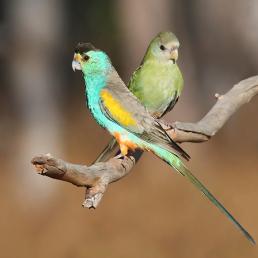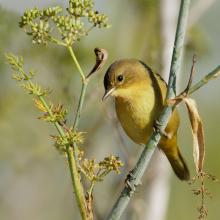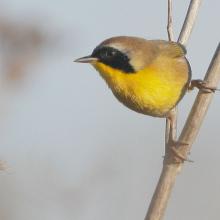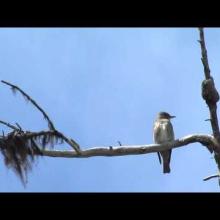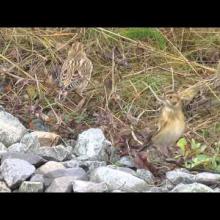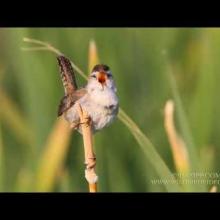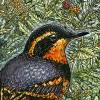

Join BirdNote tomorrow, November 30th!
Illustrator David Sibley and actor H. Jon Benjamin will face off in the bird illustration battle of the century during BirdNote's Year-end Celebration and Auction!
Different sounds travel better in different environments. The explosive notes of a Marsh Wren carry well through thick vegetation. A Common Yellowthroat's choppy, repetitive song rattles right through a stand of cattails. An Olive-sided Flycatcher sings from atop a tall tree, its song carrying at least half a mile through the open air. High-pitched sounds have shorter wavelengths and are more easily stopped by solid objects, so they are better sung from the tree-tops. Explosive, low-pitched songs bounce better past solid obstacles.
And this Lapland Longspur, with neither tall trees nor dense shrubs to sing from? It often takes flight or sits atop a tussock and sings across the Arctic tundra.
This show brought to you by the Bobolink Foundation.
BirdNote®
Bird Songs Reflect the Environment
Written by Bob Sundstrom
This is BirdNote.
[A western U.S. Marsh Wren song]
To our ears, the song of a Marsh Wren may not be the most pleasing. But in a dense habitat of cattails, it’s remarkably effective. [Continue the Marsh Wren] The ratchety, low-pitched, explosive notes – like from a tiny machine gun – carry well through the thick vegetation. Similarly, the wren’s next-door neighbor, the Common Yellowthroat, sings a choppy, repetitive song designed to rattle right through a stand of cattails. [Common Yellowthroat song]
Along the edge of the same marsh, an Olive-sided Flycatcher sings, perched atop a tall tree. [Olive-sided Flycatcher] Its high-pitched, whistled song carries at least half a mile through the open air. Sharp, clear notes are ideal for a tree-top singer.
[Olive-sided Flycatcher]
Different sounds travel better in different environments. High-pitched sounds have shorter wave-lengths and are more easily stopped by solid objects – so they are better sung from the tree tops. [Olive-sided Flycatcher] Explosive, low-pitched songs bounce better past solid obstacles, whether tree trunks or dense cattails. [Marsh Wren song] And so much depends on the birds getting their message across.
What about birds that have neither tall trees nor dense shrubs to sing from, like the Lapland Longspur? [Lapland Longspur song] The longspur often takes flight to sing, casting its gentle song into the air as it glides above the Arctic tundra.
[Lapland Longspur song]
Today’s show brought to you by The Bobolink Foundation. For BirdNote, I’m Michael Stein.
###
Sounds of the birds provided by The Macaulay Library of Natural Sounds at the Cornell Lab of Ornithology, Ithaca, New York. Marsh Wren [48819] recorded by K.J. Colver; Common Yellowthroat [79476] recorded W.L. Hershberger; Olive-sided Flycatcher [126484] recorded by T.G. Sander; Lapland Longspur [132125] recorded by G. Vyn.
Producer: John Kessler
Executive Producer: Chris Peterson
© 2014 Tune In to Nature.org May 2017/2019 Narrator: Michael Stein
ID# sound-11-2012-05-14
